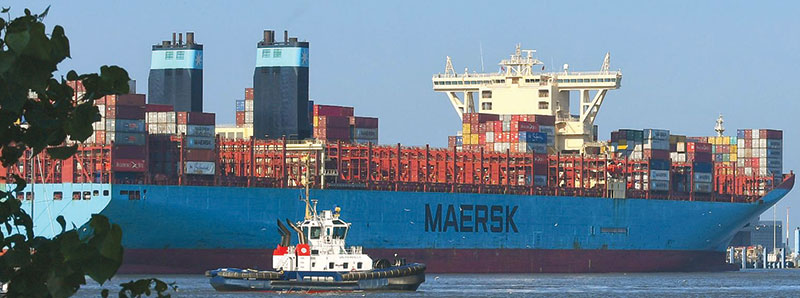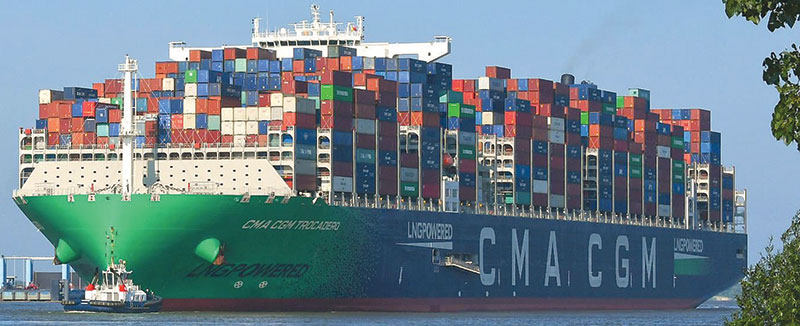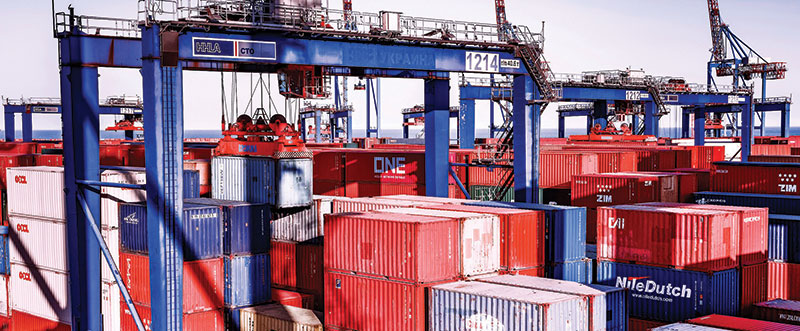European Logistics: From one crisis to the next
Europe’s transport and logistics industry faces new challenges.
The transport and logistics industry in Europe started into the new year with high expectations. There was great hope of finally getting out of the crisis mode after COVID restrictions were lifted that had brought consequences that still affect the industry. And, Brexit keeps leading to strife between the U.K. and the EU.
The further customs regulations and the ongoing dispute over the borders with Northern Ireland are putting a strain on cross-border traffic. However, the Russian attack on Ukraine dwarfs all other problems, as it has immediate consequences not only for Europe, but also threatens our global security and our global supply chains.
European ports between hope and worry
After pandemic-related declines during the past years, Europe’s leading North Range ports recorded increases in cargo and container throughput in 2021 and are back on route to the pre-pandemic level of 2019.
Total cargo throughput in Rotterdam rose 7.3% to 468.7 million tons in 2021. The number of containers increased by 6.6% to 15.3 million TEU compared with 2020, resulting from higher spending on goods during the pandemic. In liquid bulk, the economic upturn led to higher throughput of crude oil and oil products.
LNG drove growth with an increase of 12.4% over 2020, triggered by higher gas prices in Europe, which led to higher LNG imports there. Overall, liquid bulk cargo throughput was 6.6% higher in 2021 than in the previous year but 3.1% below 2019.
The Port of Antwerp also performed strongly despite disruptions in the global supply chain. Cargo throughput in 2021 totaled at 240 million tons with a growth rate of 3.8% compared to 2020 and slightly above the 2019 volume, while container traffic reached a volume of 12.02 million TEU (-0.1%) in 2021. The port will continue finalizing the merger with the Port of Zeebrugge during the coming months. The official launch of the Port of Antwerp-Bruges is planned for the end of April.
The Port of Hamburg also showed a clear recovery with seaborne cargo throughput at 128.7 million tons (+2% vs. 2020, -5.8% vs. 2019 at 136.6 million tons) and container throughput at 8.7 million TEU (+2.2% vs. 2020, -6.5% vs. 2019 at 9.3 million TEU). Container traffic with Hamburg’s second biggest trade partner, the United States, also increased 4.5% over 2020 (total 0.6 million TEU). Hamburg is looking ahead after completion of the fairway adjustment, as Megamax vessels with a breadth of up to 62.50 meters or a length of 400 meters and a draft of up to 13.10 meters can now sail into the port.
According to Rotterdam’s and Hamburg’s port representatives, the further development of throughput this year is difficult to forecast, as the war against Ukraine and the sanctions against Russia and Belarus will have long-term effects on transport to these regions and on global supply chains.
Russia accounts for 62 million tons (13%) of the nearly 470 million tons handled in the Port of Rotterdam. The port is a main hub for raw materials in Europe and large amounts of fuels are imported from Russia via the port.
Currently, 25% of the LNG, 30% of the crude oil, and 20% of the oil products and coal comes from Russia. The country also exports products such as steel, copper, aluminum, and nickel via Rotterdam. This is not yet covered by the trade restrictions announced by the European Union.
Rotterdam’s Port Authority CEO Allard Castelein says that it’s impossible to know what the developments in Ukraine will mean for these flows in the coming period. He fears that a further escalation of the conflict could have major consequences.

Port of Hamburg Marketing’s CEO Axel Mattern also expects that the war in Ukraine will affect the development of cargo handling in the Port of Hamburg. The port has not been handling any containers to or from Russia since March 1, 2022. Most of the 10 liner services connecting Hamburg with ports in Russia have already stopped. “However, it is not yet possible to say to what extent the EU sanctions against Russia will affect the development of handling this year,” he says.
The current package of sanctions is much larger than during the Crimea crisis in 2014 when Hamburg has lost around 300,000 TEU in trade with Russia. The handling of bulk goods such as paper and wood was also hardly affected.
Shipping industry under pressure
The Russian invasion of Ukraine has led to the suspension of operations in all Ukrainian ports in the Black Sea and the Sea of Azov, including Ukraine’s most important port, Odessa.
The international liner shipping companies reacted with an immediate booking stop first for cargo to and from Ukraine, then for cargo that was no longer allowed to be transported to and from Russian ports due to the EU sanctions in force against Russia.
Except for COSCO, five of the world’s six largest liner shipping companies (CMA CGM, MSC, Maersk, Hapag-Lloyd and ONE) have dropped Russia from their schedule. The consequences are backlogs and delays in various European transshipment ports, as re-routing and interim storage of cargo are often difficult to manage due to the lack of capacity and cause additional costs. MSC has already warned that alternative capacities for unloading cargo at port sites, for example in the Black Sea and the Mediterranean, are becoming increasingly scarce.
“We expect the impact of the Ukraine crisis to lead to additional challenges within disrupted supply chains,” MSC announced. CMA CGM said that Ukrainian cargo will be distributed to the ports of Constance, Tripoli, and Piraeus, while Maersk will discharge and temporarily store containers in Turkish ports.
With the shutdown of Ukrainian ports and the suspension of large parts of sea freight shipping to and from Russian ports, the war in Ukraine also has an overall economic impact on trade. Increasing inflation and supply bottlenecks for oil, gas, metals, grain, and other types of cargo also mean additional uncertainty for the operational business of shipping lines and their customers.
As the war continues, the shipping industry expects to see further price increases in freight and charter rates, especially for crude oil tankers, but also in war insurance premiums for vessels. Furthermore, there are fears of further EU sanctions against Russia.
After already having banned Russian aircraft from EU airspace, the European Union is considering closing all European ports to Russian vessels, as will be announced in due course, a European Commission spokesperson said in March. The European Parliament will vote on a non-binding resolution calling for EU ports to be closed to Russian ships and ships coming to or from Russia, except for “necessary justified humanitarian reasons.” This would cut Russia off from most maritime traffic and world trade.

Great Britain already closed its ports to all ships that are Russian owned, operated, controlled, chartered, registered, or flagged and announced that it would stop importing oil from Russia by the end of this year.
Supply chain disruption due to labor shortage
The ongoing war in Ukraine, the COVID pandemic, and the impact of Brexit have also further worsened the labor shortage in Europe and have put additional pressure on supply chains.
According to statistics from the business group Logistics U.K., the number of truck drivers in Great Britain fell by 49,000 in the fourth quarter of 2021 compared to the fourth quarter of 2019. But driver shortages are not limited to the U.K. According to IRU survey results, the current shortage is estimated to be between 40,000-50,000 drivers in France and up to 65,000 in Germany.
As Eastern European transport fleets operate large parts of the truck traffic in Europe, the fear is great that the Russian invasion of the Ukraine will exacerbate the labor shortage. It’s known within the industry that many drivers employed in Poland come from Ukraine. Most of them cannot pursue their profession in the current situation, either because they have been summoned to defend their home country or are returning to support and secure their families.
Klaus Meyer, Chairman of the Logistics and Mobility Commission of Germany’s SME Association BVMW, warned: “We are talking here about an estimated 100,000 Ukrainian drivers who are currently in Poland alone and who could soon no longer be available to transport companies.”
On both sides of the Ukrainian-Russian border, truck drivers were also stuck or have come under fire. According to IRU, at least 600 Turkish drivers are also stuck in Ukraine. RoRo ferries to Turkey have been cancelled and Ukraine’s Black Sea ports are closed. The drivers are now trying to get home via the EU.
The International Chamber of Shipping (ICS), which represents 80% of the fleet, also points out another problem. The organization has warned of further supply chain disruptions should the free movement of Ukrainian and Russian seafarers be impeded. The Seafarer Workforce Report, published in 2021 by Bimco and ICS, reports that 1.89 million seafarers are currently operating over 74,000 vessels in the global merchant fleet. Of this total workforce, 198,123 (10.5%) of seafarers are Russians and 76,442 (4%) are Ukrainians. Combined, they represent 14.5% of the global workforce.
The travel restrictions brought on by the pandemic have already resulted in a shortage of seafarers to crew merchant ships. ICS warns that a possible ban on seafarers from nations at war will make the manning of vessels even more difficult.
Brexit: A never-ending story
With the Ukraine war currently in the spotlight, the Brexit conflict has taken a back seat but is still going on. A year after Great Britain left the European Union and its single market, a second phase of the process has begun.

This will mean increased customs controls and paperwork for goods shipped between the EU and Britain. Customs, VAT, and excise taxes have been due on goods shipped between Britain and the EU since the beginning of 2021. However, Britain had granted a grace period on some provisions in the trade agreement for the first year.
As of January 1, 2022, full customs declarations are required upfront for imports to Great Britain from all EU countries except Ireland. Any applicable tariffs must be paid immediately.
British customs introduced an IT platform, the Goods Movement Vehicle Service GVMS, to expedite handling. All declarations can be completed before cargo leaves the EU and clearance takes place during shipping or in the port of entry. However, failure to provide proper paperwork can mean shipments will be held at the shipper’s expense.
Food products are particularly affected, with mandatory pre-notification for agri-food imports and veterinary certification. However, the British government is postponing across-the-board physical checks on agri-food shipments until July 1. The EU introduced full customs controls at the beginning of 2021.
French customs reported that operations generally ran smoothly during the first year, with 80% of the trucks not having to stop at the border. A digital system helped ease the red tape, despite import declarations increasing by around a third and transit papers by two-thirds. France had to handle six times more export paperwork for cross-channel trade.

The first year of Brexit had various effects on commerce. Britain has been hit particularly hard by supply chain disruptions and shortages of drivers and other workers. Trade dropped sharply at first before recovering somewhat.
BBC reports that total EU-U.K. trade is still at the low level of the 2020 pandemic. In comparison, trade between the U.S. and the EU rose 18% in January-October of 2021. According to the EU statistics agency, British exports to the EU fell nearly 15% in the first 10 months, while agri-food exports dropped by more than a quarter.
Cross-border trade between Ireland and Northern Ireland boomed in both directions and Irish exports to Great Britain increased, but British exports to Ireland dropped. Previously, Ireland’s biggest single trade partner, the U.K. is now even with the United States, each accounting for about 20% of Irish imports.
Northern Ireland’s politically vital open border with the Republic of Ireland complicates matters. Among the Brexit agreements is the Northern Ireland Protocol, which left Northern Ireland in the European single market, thus allowing the border with Ireland (an EU member) to remain open. This effectively created a border for goods traffic between Northern Ireland and the rest of the U.K. because British goods must be checked before entering Northern Ireland, where European rules apply.
The NI protocol has been highly controversial within the U.K. and an ongoing source of strife with the EU. The British government has been demanding an overhaul of the agreement, which it sees as hindering movement of goods. Prime Minister Johnson has threatened to suspend parts of the protocol unilaterally.
At the beginning of February, the Northern Ireland minister of agriculture ordered a halt to border checks, but this was overturned in court. High-level negotiations between the European Commission and the U.K. are continuing but no solution is in sight. Other open issues involve fishery and financial services.
Even if the EU and the U.K. still have much to discuss if they are to find a solution to the contentious issues of Brexit, the war against Ukraine shows that Europe stands together in a crisis. This also applies to the transport and logistics industry, which proves how crisis management can work successfully, especially in difficult times.

Article Topics
Global Trade News & Resources
UPS reports first quarter earnings decline Supply Chain Stability Index sees ‘Tremendous Improvement’ in 2023 Descartes March Global Shipping Report highlights ongoing steady volume momentum U.S.-bound import growth track remains promising, notes Port Tracker report EU Update 2024: Crises lead to growth Examining the impact of the Taiwan earthquake on global supply chain operations Descartes announces acquisition of OCR Services Inc. More Global TradeLatest in Logistics
Shipment and expenditure decreases trend down, notes Cass Freight Index March trucking tonnage trends down, reports ATA FTR Shippers Conditions Index enters negative territory DAT March Truckload Volume Index sees modest March gains National diesel average, for week of April 22, is down for the second straight week UPS reports first quarter earnings decline LM Podcast Series: Assessing the freight transportation and logistics markets with Tom Nightingale, AFS Logistics More LogisticsSubscribe to Logistics Management Magazine

Find out what the world's most innovative companies are doing to improve productivity in their plants and distribution centers.
Start your FREE subscription today.
April 2023 Logistics Management

Latest Resources
















